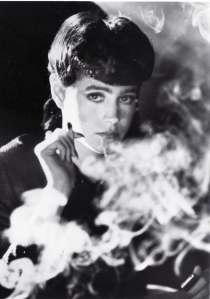In an essay by William Timberman titled “The Future of Our Discontents“, he comments on the visual use of smoke in Blade Runner:
“almost everyone in Blade Runner smokes — the impenetrable tobacco haze is an important visual element in many of the interior scenes. It isn’t clear, in an age when smoking has become anathema, an almost universal symbol of dissipation and self-contempt, what Scott intends by giving it such pride of place in his version of the twenty-first century.
The answer, I think, is that the smoking in Blade Runner is intended as an echo, a reminder that all the poisonous exhalations of a capitalist society are voluntary. The fatal eroticism embodied in the fumes from Rachael’s smoldering cigarette is repeated in the orange skies above Los Angeles, in the continual dark rain which beats along its decaying rooftops and licks at the trash fires in its streets. Consumption pursued as an end in itself, Scott seems to be saying, will lead to the same, slow catastrophe whether it is an individual or an entire society which does the pursuing.”
In a book by David Pinder called Visions of the City:Utopianism, Power. and Politics , something he said about the role of utopianism in the imagination and perception of the city seemed related to the project of Sci-Fi futurism/urbanism in the stories we’ve looked at so-far.
For Pinder, to envision a utopia in an urban/spatial form works to disrupt the “seemingly inevitable reproduction of the present”. Envisioning is about “developing projects, events, situations and struggles through which other possibilities become more tangible and what is revealed as truly absurd is the claim, not that there are alternatives to be won, but that there aren’t any. Isn’t that the really shocking proposal, that this is it?”.
I thought it was interesting how the role of smoking in the L.A. of 2019 also creates this sense of possibility and choice in the movie’s depiction of what may come out of the actual reproduction of present trends. (Trends such as hyper-globalization with no clear direction, coupled with the persistence of uncertainty so inherent in the human experience).

George, this is a really fascinating, and particularly beautiful way of thinking about the movie; the post title and image alone have a bewildering logic to them.
I’m still trying to think through that point at the end, the connection you’re making between Pinder and Timberman’s ideas. Haven’t read the articles but get this feeling so far: something about the city’s hazy occlusions (the perpetual darkness, the fog – and in Timberman’s case, the cigarette smoke) striking a visual ambiguity in the film that close us into a kind of (capitalist?) prognostic ambivalence – a simulated present-ness or immediacy in the individual’s limited point of view, where literal myopia connotes a metaphorical absence of foresight and therefore an abundance of possibility, an indeterminate future.
The effluence of late-capitalism? (its own death-rattle?) The makings of an anti-utopia? To me it seems to locate a sense of optimism within the dystopic – mimics a familiar rhetoric of “hope” in a troubled atmosphere, and of course without concrete, foreseeable outcomes.
…the cigar as a leitmotif for the development of the Bowery